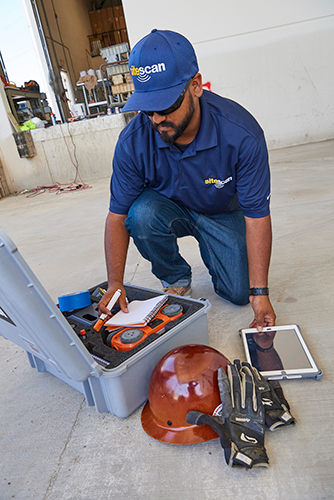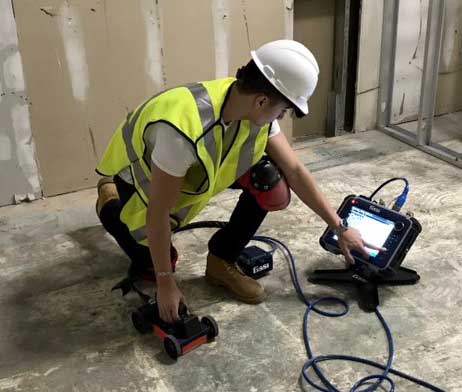Specialist Tips for Optimal Concrete Scanning Outcomes
Specialist Tips for Optimal Concrete Scanning Outcomes
Blog Article
Introduce the Transformative Power of Concrete Scanning in Taking Full Advantage Of Performance and Security
Concrete scanning has actually become an important device in the building sector, offering exceptional advantages in improving task effectiveness and ensuring safety standards. By making use of innovative modern technology, concrete scanning allows professionals to see beyond the surface, discovering covert intricacies that could impact the architectural stability of a structure. The transformative power of concrete scanning depends on its ability to offer real-time data and detailed understandings, changing exactly how jobs are intended and implemented. As we dive right into the details of this cutting-edge strategy, a world of possibilities opens up, showcasing a new age of building and construction techniques that prioritize precision and protection.
Significance of Concrete Scanning
Making certain the architectural honesty and safety of building jobs begins with the critical action of performing comprehensive concrete scanning. Concrete scanning is a non-destructive method utilized to identify and map subsurface aspects within concrete structures.
In addition, concrete scanning assists in optimizing job timelines and spending plan by avoiding unforeseen costs and delays that may develop due to unexpected blockages within the concrete. Ultimately, investing in comprehensive concrete scanning is a proactive technique that improves both performance and security in construction projects.
Just How Concrete Scanning Works
Concrete scanning runs as an essential device in building and construction tasks by using advanced innovations to detect and map subsurface components without causing structural damage. Ground Permeating Radar (GPR) and Electromagnetic Induction (EMI) are two key approaches made use of in concrete scanning. GPR jobs by releasing high-frequency radar pulses right into the surface area, which recuperate when they encounter subsurface objects or gaps. The time considered the signal to return shows the depth and area of the objects. EMI, on the various other hand, uses electro-magnetic fields to recognize variations in material structures, such as recognizing rebar or conduits within concrete frameworks.
During the scanning process, the data collected is examined in real-time, allowing prompt recognition of potential hazards or obstacles under the surface area. This details help in decision-making, making certain that building and construction activities proceed safely and efficiently. Furthermore, 3D imaging software can be made use of to produce topographic maps of the subsurface components, even more enhancing project planning and implementation. By using these sophisticated technologies, concrete scanning dramatically lowers the threat of costly problems and injuries on building and construction websites.
Benefits of Concrete Scanning
One of the main advantages of concrete scanning is the capacity to discover and find embedded objects such as rebar, post-tension cords, and avenues precisely. Concrete scanning aids in planning and designing much more successfully, as it provides accurate info about the area and depth of architectural elements.

Situation Research Studies: Concrete Scanning Success

In one more instance, a building firm used 3D concrete scanning to analyze the condition old concrete frameworks in a historic structure. The thorough scans given valuable understandings into the extent of damage and aided prioritize upkeep efforts efficiently. By proactively dealing with locations of problem determined with scanning, the business had the ability to expand the lifespan of the framework and guarantee owner safety.
These situation studies underscore the transformative power of concrete scanning in improving effectiveness, precision, and security in building projects.
Implementing Concrete Scanning in Projects
Implementing advanced scanning modern technologies throughout building tasks has become progressively necessary for enhancing precision and safety and security. By incorporating concrete scanning into job preparation and execution, construction teams can identify potential hazards, such as rebar or post-tension cable televisions, concealed within concrete frameworks. This aggressive strategy reduces the risk of crashes, delays, and pricey rework, ultimately causing extra reliable Recommended Reading project timelines and budget plans.
To carry out concrete scanning successfully, project supervisors need to team up carefully with knowledgeable scanning specialists to identify one of the most suitable scanning techniques for the certain project requirements. Involving scanning specialists from the onset of a project makes it possible for the group to create extensive scanning strategies that deal with key areas of concern and make certain comprehensive data collection.
Moreover, including concrete scanning right into routine project workflows can simplify decision-making procedures, as real-time scan data provides immediate insights into the problem of concrete frameworks - Concrete Scanning. This data-driven strategy assists in notified analytic and allows groups to make modifications quickly, cultivating a culture of performance and security throughout the job lifecycle

Verdict
Finally, concrete scanning plays a critical duty in enhancing effectiveness and safety in building and construction jobs. By utilizing sophisticated innovation to map and discover browse around this site out underlying frameworks within concrete, this process assists to protect against expensive blunders, make sure architectural stability, and lessen risks on website. With the capability to discover covert components and provide precise data, concrete scanning shows to be an important device for optimizing task outcomes and making best use of total success.
Concrete scanning is a non-destructive approach utilized to find and map subsurface elements within concrete structures. Additionally, concrete scanning assists in optimizing job timelines and budget by staying clear of unforeseen expenses and delays that may arise due to unanticipated blockages within the concrete. One notable case research involves a large-scale renovation project where concrete scanning played a critical role in making certain project success.In an additional situation, a building and construction company utilized 3D concrete scanning to evaluate the condition of maturing concrete structures in a historical building. By incorporating concrete scanning into project preparation and execution, construction teams can identify possible hazards, such as rebar or post-tension cables, hidden within concrete structures.
Report this page